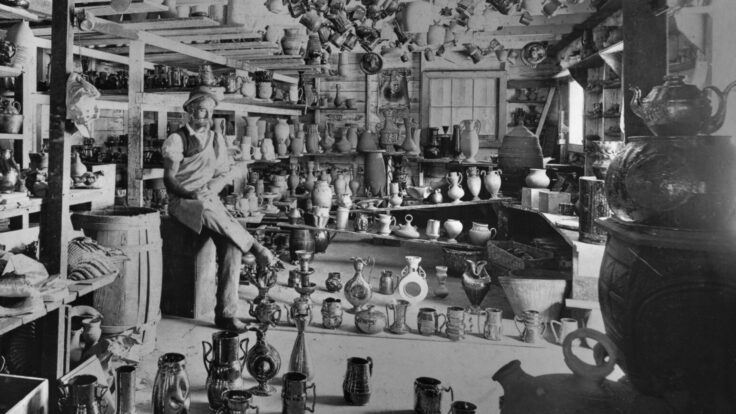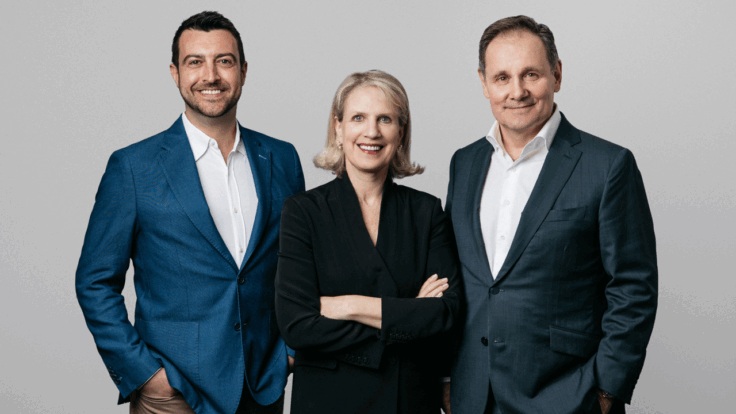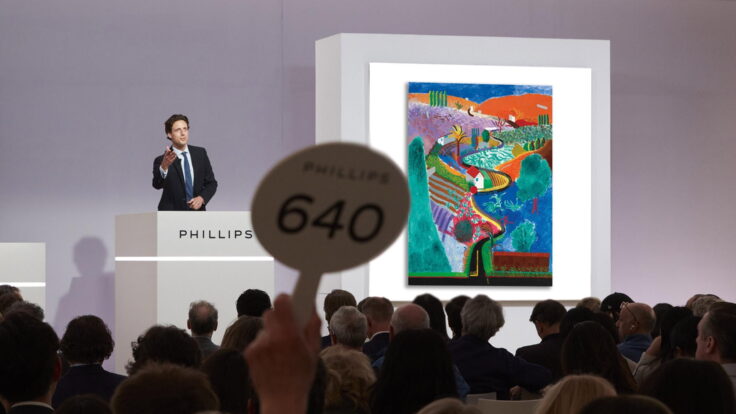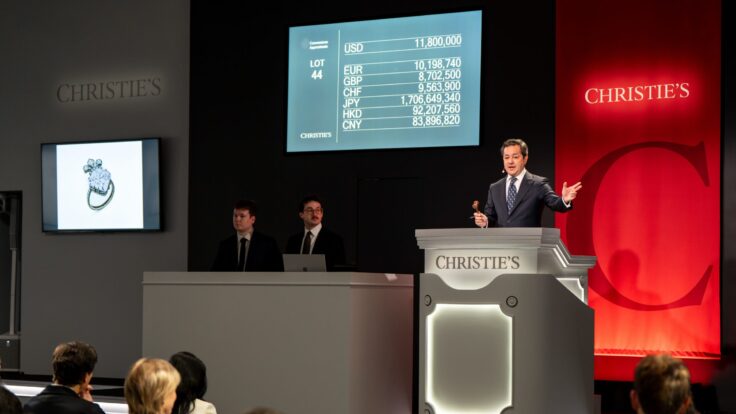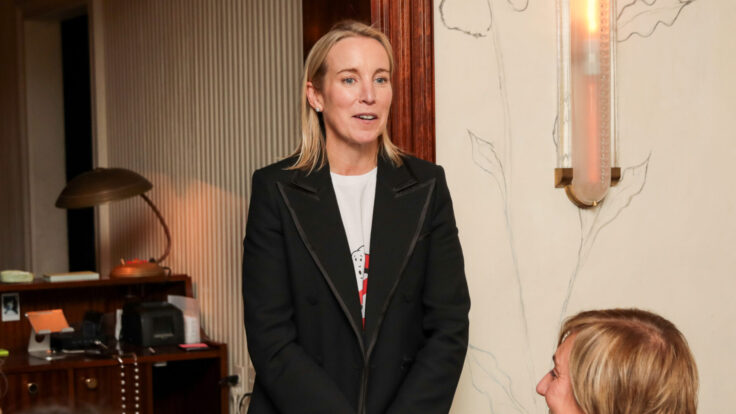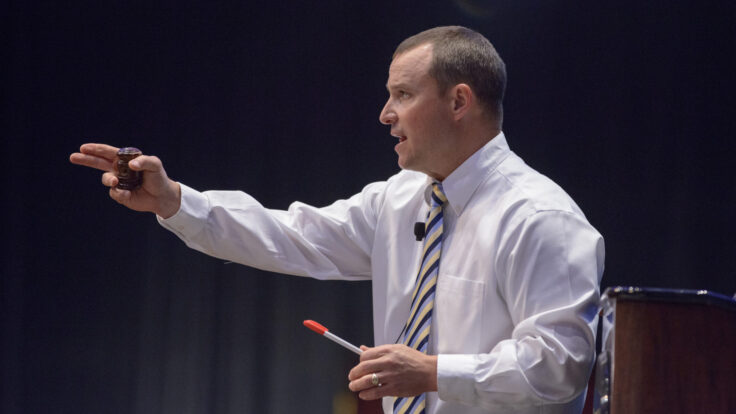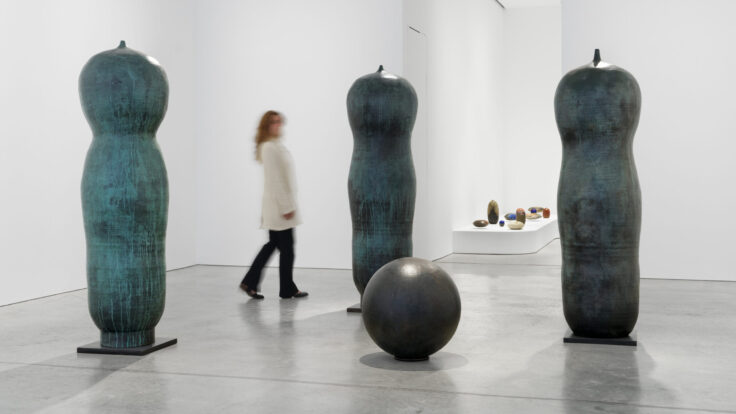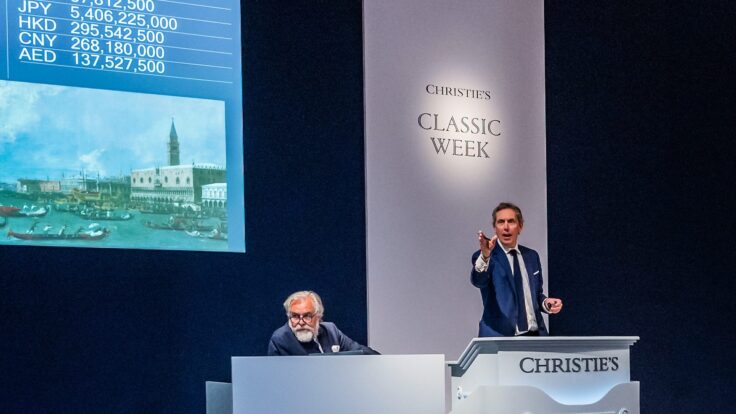Greetings! As you can probably tell, today’s newsletter looks a little different.
After three years, we’ve redesigned the look and feel of our private emails, and want to know what you think. If you have any feedback, please click here to take a brief survey.
|
Welcome to the final Wall Power of 2024. I’m Marion Maneker.
Before you settle into your long holiday break, I want to tie up a few loose ends. It feels like a lot more is happening in the art and the auction markets than a few personnel changes at the top of Phillips and Sotheby’s. But I’ll leave that to next year to explore. For now, let’s look at last week’s final bombs: the C.E.O. handoff at Phillips from Ed Dolman to Martin Wilson, and Sotheby’s abrupt volte-face on their new fee structure.
By the way, if you haven’t taken our survey for the second installment of The Puck Private Conversation series, powered by Orchestra, you can fill out your responses here. It’s fun—this installment is all about how businesses are navigating the Trump transition—and only takes a minute or two.
|
|
|
|
A MESSAGE FROM OUR SPONSOR
|
|
Iconic Collection welcomes you to the cutting-edge world of luxury brands and experiences. More
than just shopping centers, these are destinations for the next generation of consumers where traditional retail is reimagined through innovation, sustainability, community partnerships, and one-of-a-kind experiences. Each Iconic Collection property provides visitors with high-profile retailers, eclectic culinary feats, and cultural concepts in inspiring settings. Furthermore, Iconic magazine extends this mission and commitment to print. Every issue examines the world of fashion, tech, retail,
and beyond. Uncover upcoming trends, meet industry game changers, learn the art and story behind each Iconic Collection property, and so much more.
|
|
|
- Phillips to Sotheby’s: Hold my beer!: On Wednesday, Phillips announced that C.E.O. Edward Dolman was stepping down in favor of the company’s chief legal officer, Martin Wilson—the latest in a series of executive changes at the auction house. In recent years, Phillips has made strides as a specialty house that excels at making markets for the work of emerging artists and selling select high-value property. But to truly compete against Christie’s and Sotheby’s for the big estates, Phillips needs a bigger balance sheet. Hence, there were persistent rumors, several years back, that Phillips was looking for a buyer—until it wasn’t. By all accounts, the owner, Russian luxury-mall-and-real-estate developer The Mercury Group, had been offered a good price for the firm. Ultimately, it decided not to sell.
Dolman, who is 64, had been making it clear for some time that he’d had enough of running a business day to day. He became a C.E.O. at 39—and has run three different institutions in the 25 years since. In 2021, he hired the widely liked Stephen Brooks, a former Christie’s chief operating officer, as C.E.O. to replace him; but Brooks left earlier this year. Dolman then tried another tack (he’s a sailor), promoting the also widely liked Amanda Lo Iacono into the new role of deputy C.E.O. But Lo Iacono has decided she’s had enough as well. Now, Dolman has set a date in May for his departure, and Wilson (another well-liked Christie’s veteran who is also involved in all of the company’s deals) is stepping in. What makes the management churn and succession confusion so surprising is Phillips’ reputation as the nice-guy, no-drama auction house. It would be a shame to see that change.
- Sebastian Fahey to depart Sotheby’s: Among the several announcements that dropped last week, Sotheby’s informed staff that the managing director of the Global Fine Art division, Sebastian Fahey, would be leaving the company. Fahey, the highest-ranking cut announced thus far, had worked for Sotheby’s for 20 years—in London, Hong Kong, and, most recently, New York. In an email, the company said it would be “revisiting the overall organizational structure of GFA” and “sharing a new org design and reporting lines in January.” I’m told that Fahey may have had as many as 28 direct reports after the departure of GFA head Brooke Lampley earlier this year.
- That’s half a million per commandment: Sotheby’s ended the year with a banging $5 million sale of a stone tablet that is purported to be a “copy” of the Ten Commandments. The object was purchased eight years ago for $850,000 and will now, according to Sotheby’s, be donated to a museum in Israel. The New York Times is having none of it. A week before the sale, the newspaper contacted two scholars who provided a long list of reasons to doubt the stone’s origins and authenticity. Basically, since the object was not found on an archaeological site, which would have properly documented its discovery, and because much of its lore is impossible to independently verify—there’s no carbon dating on stone, and the best argument for the object is the alphabet used for the inscription—the Times issued a prominent caveat emptor.
When its warnings were not heeded, the paper followed up with an even stronger consumer report, quoting the two scholars from the original article, and adding a third who warned that “doubts about the tablet ‘should be taken seriously.’” This is one of the great things about the auction market and the sale of a wide range of objects that have complex backstories, ranging from dinosaur fossils to works by Leonardo da Vinci: Individual bidders decide what to believe and how much to spend based upon those beliefs, not what the Times says.
|
|
|
|
A bold new fee structure was meant to transform the auction business—lower buyers fees to spur business and end the brutal price war between the auction houses. But after Sotheby’s struggled to land property in all of its main sales centers, it quietly reversed course in the final days of the year… effectively burying the news.
|
|
|
To hear Sotheby’s tell it, the change in its fee structure earlier this year was a bold and heroic effort to fix the auction business. And so there was no shortage of defensiveness, last week, when the auction house announced it was walking back those changes, raising the most broadly applicable buyer’s premium from 20 to 27 percent. In an interview with The Art Newspaper, C.E.O. Charles Stewart noted defiantly, “We are totally unafraid to try things that challenge conventions in ways that benefit the market and expand access to growing audiences.”
But the new fee structure ended up being anything but expansive. Supply in the art market was already constrained by other factors—prices haven’t gone up in a long time, and collectors just don’t want to let things go—and Sotheby’s fee changes, which went into effect after the May sales, made it even harder to land good property to sell. The house had to delay its Hong Kong evening sale of contemporary art due to a lack of property; its London day and evening sales were sparse; there was no day sale in Paris; even in New York, it appeared that Sotheby’s finance arm had pushed some lots to the day sale to improve numbers. But Stewart deflected blame for the failed experiment onto others, complaining that “the market doubled down on the status quo” and pointing a finger at “people used to consigning with us and those with art advisors.”
|
|
|
|
A MESSAGE FROM OUR SPONSOR
|
|
Iconic Collection welcomes you to the cutting-edge world of luxury brands and experiences. More than just shopping centers, these are destinations for the next generation of consumers where traditional retail is reimagined through innovation, sustainability, community partnerships, and one-of-a-kind experiences. Each Iconic Collection property provides visitors with high-profile retailers, eclectic culinary feats, and cultural concepts in inspiring settings. Furthermore, Iconic magazine extends this mission and commitment to print. Every issue examines the world of fashion, tech, retail, and beyond. Uncover upcoming trends, meet industry game changers, learn the art and story behind each Iconic Collection property, and so much more.
|
|
|
So much for this being a buyer’s market. In response to the announced reversal on fees, some art advisors took to Instagram to say that the vendor’s commission had proved an obstacle for them in making day sale consignments. The end of enhanced hammer on deals below $50 million—where the auction house cuts the consignor in on the buyer’s premium as an added inducement—also turned off advisors, who often use those rebates to justify their own fees.
There was also ample evidence that the lower buyer’s premium was not causing bidders to throw caution to the wind as Sotheby’s had hoped. Two Rembrandt etchings were sold this month in London, as the data firm Pi-Ex noted, but the one at Sotheby’s, estimated at half the price of the other, failed to sell, while its doppelgänger made a price 25 percent above its estimate. There are too many other factors (provenance, condition) to call this evidence of the fee structure’s failure, but it did indicate that the lower buyer’s premium could not overcome the other factors. And even though Sotheby’s claimed victory in an internal email announcing the end of the lower buyer’s premium—which, the auction house claimed, “removed barriers to entry for new collectors and brought greater transparency to the market, helping to drive a record number of bidders and the strongest sell-through rates in years”—I’ve seen data comparing the fates of 55 identical items at Sotheby’s and Christie’s that makes it clear the lowered buyer’s premium just wasn’t moving the needle.
And so, last week, Sotheby’s announced internally that it will be “reintroducing selective flexibility on seller’s financial terms” in February, which means everything is up for negotiation if you’ve got the goods. Externally, the house set the new fee structure at 27 percent on purchases up to $1 million; 22 percent from $1 million to $8 million; and 15 percent thereafter. (Christie’s charges 26 percent up to $1 million; 21 percent to $6 million; and 15 percent thereafter; Phillips’ fees are 27 percent to $1 million; 21 percent to $6 million; 14.5 percent thereafter.) Yes, you read that right: Sotheby’s raised its fees above its competitors’.
It’s a smart move by Sotheby’s to cut its losses and raise its rates, which gives them more negotiating room against Christie’s to regain selling position in the new year. One European collector I know described the rate change email, which arrived after the company endured a traumatic week of layoffs while an absent Stewart was bragging on Instagram about his trip to Abu Dhabi, as a “P.R. clusterfuck.” I get that. But I don’t fully understand why Sotheby’s isn’t making a virtue of this wholesale restructuring of the company by giving the layoffs some time to breathe and then announcing the new fees at the beginning of the new year, so they can mark a fresh start. Clearly, leadership sees the about-face as a black eye rather than something to celebrate.
|
I happened to be speaking to another auction veteran at the very moment Sotheby’s email started hitting inboxes. Surprisingly, the veteran initially expressed disappointment that Christie’s C.E.O. Guillaume Cerutti had done nothing to support Sotheby’s in reshaping the auction house revenue structure. The auction business is in a real bind, the veteran explained. Something has to change, and piling on more buyer’s premium, only to give it away to consignors in a brutally competitive marketplace for acquiring property, is a path leading toward self-destruction.
Of course, the auction houses are precluded from coordinating their pricing with the competition. It’s illegal; and, within living memory for employees at both houses, the late Alfred Taubman, who bought Sotheby’s in 1983 and eventually took it public, went to federal prison for a year simply for opening the door to collusion. That said, the auction houses have ways to signal their intentions that are legal and above board. The problem, the auction veteran admitted, was that Sotheby’s came in with a “hard opening bid.”
Its rival seems to have felt the same way. I was told by someone familiar with the thinking at the top of Christie’s that, in their view, Sotheby’s tried to do too much: re-establish the vendor’s commission; end enhanced hammer deals below $50 million; and lower the buyer’s premium to 20 percent—too quickly. As I mentioned back in April, the lower fees looked like part of a Sotheby’s campaign to raise new capital. It’s likely Patrick Drahi and Stewart had to show they were willing to do something dramatic and different in order to get Abu Dhabi’s money. Restructuring the auction house’s main source of income certainly qualified, but the audacity to “ challenge conventions,” as Stewart put it to The Art Newspaper, isn’t a substitute for execution.
|
|
|
|
In the end, Sotheby’s didn’t have the balance sheet to stick it out and show Christie’s it was committed to these changes over the long term—or the runway to signal that its intentions were in everyone’s best interest. If Stewart and Drahi had been serious about improving the economics and margins of the business, they would have made a series of measured moves that Christie’s and Phillips could have responded to, building trust and cooperation over time. Instead, they went all in, but didn’t have the cards to back it up. By all internal accounts, Stewart had been blithely confident that Christie’s would follow his lead on fees—a failure to read his opponent that only compounded the problem.
Cerutti, for his part, is widely known to be hyper-competitive. Folks at Sotheby’s complain, with some justification, that he has targeted some of their consignments—notably, works by Willem de Kooning and Joan Mitchell—with gratuitous counterprogramming. But presented with so many ways to press an advantage over his rivals, there was little chance Cerutti was going to level the playing field entirely.
Sotheby’s moved so far, so fast, that Cerutti was able to improve his own negotiating position with consignors while still maintaining an edge over his rivals across town. It would have been hard for him not to do it. The situation brings to mind a quote attributed to McDonald’s genius Ray Kroc. “If my competitor were drowning,” Kroc supposedly said—and I’ve heard more than a few C.E.O.s repeat this quote—“I’d walk over and put a hose right in his mouth.”
|
This is my last newsletter flying solo. Starting January 5, a pumped-up Wall Power will be hitting your inbox three times a week—with a special fourth send if you’re a member of the Inner Circle. (Upgrade your status here.) The newsletter itself will still include everything you know and love, but with my new colleague, industry veteran Julie Brener Davich, adding more scope to our coverage—especially of what makes art and cultural property alluring and valuable.
One final note: We’re shutting down the Wall Power SMS channel in the new year. That doesn’t mean we want to hear from you any less. You can always reach me by responding to this email or texting me at 917.825.1391. That number is good on WhatsApp, Signal, and regular SMS. Give it a try. I’ll text you back.
Happy Christmas to all, from those of us who do not celebrate. Wishing you joy and happiness in the new year.
M
|
|
|
|
Puck founding partner Matt Belloni takes you inside the business of Hollywood, using exclusive reporting and insight to explain the backstories on everything from Marvel movies to the streaming wars.
|
|
|
|
Lauren Sherman, a former top executive at Business of Fashion, is the preeminent fashion journalist of her generation. Line Sheet offers incisive reportage on all aspects of the industry and its biggest players. Every Wednesday, Lauren is joined by the beauty industry’s leading reporter, Rachel Strugatz, who writes the definitive guide to what’s happening across the category, from M&A to executive shuffles.
|
|
|
Need help? Review our FAQ page or contact us for assistance. For brand partnerships, email ads@puck.news.
You received this email because you signed up to receive emails from Puck, or as part of your Puck account associated with . To stop receiving this newsletter and/or manage all your email preferences, click
here.
|
|
Puck is published by Heat Media LLC. 107 Greenwich St, New York, NY 10006
|
|
|
|
